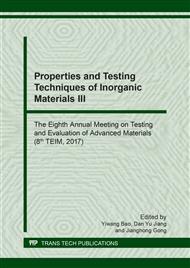[1]
Ready-mixed Concrete, GB 14902-(2003).
Google Scholar
[2]
Yi Li, Study on Energy Consumption Quote and Clean Production Assessment System of Commercial Concrete Enterprises [J], master's thesis, Wuhan University of Science and Technology.
Google Scholar
[3]
http://www.chinadmd.com/file/eivxetutaazuautvetpocciz_1.html.
Google Scholar
[4]
2006 IPCC Guidelines for National Greenhouse Gas Inventories.
Google Scholar
[5]
Gong Zhiqi and Zhang Zhihui, Study on Materialization Environmental Conditions in Cement Life Cycle, No.5, Volume 37, China Civil Engineering Journal, (2004).
Google Scholar
[6]
Wu Hong, Cui Suping et al, Analysis on Environmental Load of Cement Industry in China, No.6, China Building Materials Science & Technology, June (2006).
Google Scholar
[7]
Li Xiaopeng, Sun Xiaofeng and Li Jian, Primary Exploration for Carbon Footprint of Cement Enterprises, Cement and Concrete, No.12, China Building Materials Science & Technology, December (2010).
Google Scholar
[8]
Jiang Rui, Wang Hongtao, Zhang Hao and Chen Xuexue, Comparative Analysis and Recommendation on Life Cycle of Cement Production Process in China, Acta Scientiae Circumstantiae, No.11, Volume 30, November (2010).
Google Scholar
[9]
Xu Xiaoning et al, Life Cycle Assessment of Composite Portland Cement, Acta Scientiae Circumstantiae, No.9, Volume 33, September (2013).
Google Scholar
[10]
Data Sharing Resource Node for Environmental Load of Material, Beijing University of Technology http://matsec.ustb.edu.cn/matsharing/inex.jsp.
Google Scholar
[11]
IKE Environment. e Balance User's Manual [G/OL].[2014-5-1].
Google Scholar
[12]
Gao Yuanxue, Assessment Method and Empirical Study on Carbon Footprint in Building Product Materialization Stage, master's thesis, Tsinghua University, May (2012).
Google Scholar
[13]
Zhao Mingnan, Life Cycle Assessment on Concrete Structure Member of Ordinary Residential Buildings, master's thesis, Beijing University of Technology, (2013).
Google Scholar
[14]
Dong Kuntao, Study on Carbon Dioxide Emission from Building with Reinforced Concrete Structure, master's thesis, Qingdao Technological University, December (2011).
Google Scholar
[15]
Gao Yuxin, Wang Jun et al, Evaluation on Carbon Emission in Green Production of Ready-mixed Concrete, China Construction Ready Mixed Concrete Chengdu Co., Ltd., Concrete, No.1, (2011).
DOI: 10.1108/eb021504
Google Scholar
[16]
Lin Xiande, Zhang Yousheng et al, Analysis on Energy Consumption and Carbon Dioxide Emission from Building Material Production in Taiwan, Architectural Journal, No.40, June (2002).
Google Scholar
[17]
Peng Zhenguo et al, Study on Life Cycle Assessment Method of Typical Industrial Solid Waste, master's thesis, Beijing University of Technology, (2015).
Google Scholar
[18]
Cui Suping, Li Yao et al, Study and Practice on Life Cycle Assessment of Cement, Materials China, No.10, Volume 35, October (2016).
Google Scholar
[19]
Yin Zhidong, Study on Carbon Emission Accounting and Emission Reduction Method of Coal Products, master's thesis, Capital University of Economics and Business, March (2015).
Google Scholar
[20]
2014 Baseline Emission Factors for Regional Power Grids in China Determined by National Development and Reform Commission, http://www.tanpaifang.com/CCER/201505/1244380.html.
Google Scholar


